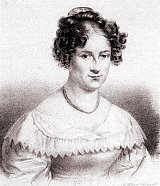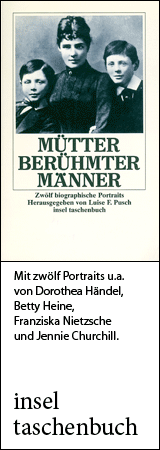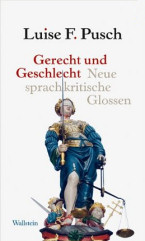Biographies Rahel Varnhagen von Ense

(Rahel Friederike Antonie Varnhagen von Ense, née Levin. Rahel Levin (maiden name); Rahel Robert or Robert-Tornow (assumed family name), Rahel Friederike Antonie Varnhagen von Ense (name after marriage and conversion to Christianity))
born on May 19, 1771 in Berlin
died on March 7, 1833 in Berlin
German thinker, writer, salonière
Biography • Quotes • Literature & Sources
Biography
“With what freedom and grace she knew how to inspire, enlighten and warm all around her! [...] I heard colossal sayings from her, true inspirations, often in just a few words, which traveled through the air like lightning bolts and struck one's innermost heart.” This is how Count Salm described the young Jewish banker's daughter Rahel Levin in her first Berlin salon (1790-1806). The social conventions of the time did not apply in that salon: actors and aristocrats as well as the poets and thinkers of the Romantic Era met here for heady discussions about literature, art and philosophy and to listen to Rahel's “Dachstubenwahrheiten” (candid truths). Here Prince Louis Ferdinand encountered his lover, the beautiful and scandalous Pauline Wiesel, Rahel's close friend, and here you could find the Schlegel brothers, Tieck, Wilhelm und Caroline von Humboldt as well as Clemens Brentano and Schleiermacher.
Rahel was revered for her witty conversation and wise judgments, and was passionate about literature as well as the new sciences. Since she was not allowed to study as a woman, she educated herself by reading the most important classical and contemporary literature, often in the original language.
It was the time of the romantic cult of friendship. Rahel lived intensely, knew the highs of enthusiasm and the lows of despair. She went out of her way for her friends, giving advice and helping when it came to secret love affairs or illegitimate children. An ardent lover herself, she experienced two passionate love affairs: the first with Count Karl von Finckenstein, the second with the Spanish diplomat Don Raphael D'Urquijo. Both relationships were broken off after lengthy engagements.
As an independent woman her view of marriage was highly critical, nevertheless she hoped to escape the “disgrace” and “misfortune” of her Jewish birth through marriage.
Rahel Varnhagen von Ense
In the end, at the age of 43 shortly after her conversion to Christianity, she married Karl August Varnhagen von Ense, 14 years her junior, who admired her and supported her work. Her comment on this marriage: “Our greatest happiness, our love, is now being prepared on the bourgeois anvil so that it will pass.” After difficult early years in Vienna, Frankfurt and in Karlsruhe, where Varnhagen was a Prussian diplomat at the court of Baden and she, as a baptized Jew, was not invited to court events, they moved back to Berlin in 1819. Her husband learned to give her the freedom she needed. Together they ran a salon but since these were the times of restoration after the Congress of Vienna and Rahel was now a married woman, it was rather more conventional than her first salon. Many of the Romantics had turned away from Rahel after embracing conservatism and Germanism. Hegel, Ranke and Börne and other progressive political thinkers socialized with them. Rahel herself was enthusiastic about Saint Simon's early socialist writings and found an intellectual heir in the young Heinrich Heine, whose genius she recognized. Bettine von Arnim also became an important friend at that time.
Throughout her life, Rachel suffered from the limitations imposed on her as a Jewish woman and saw this as the cause of her many illnesses and inner turmoil. She was well aware of her uniqueness: “I am as unique as the greatest phenomenon on this earth. The greatest artist, philosopher or poet is not above me.” (1805) Her great talent lay in conversations and letters, which expressed her feelings and thoughts spontaneously and genuinely in a language all her own. She herself had only a few texts printed anonymously late in her life - in particular her thoughts on Goethe's works - but together with Varnhagen she prepared a selection of her 10,000 letters and diaries for publication, so that the first of many posthumous works could be published just three months after her death: Rahel. A Book of Remembrance for her Friends (1833).
(German text from 1999; translated in 2025 by the author, Gabriele Koch.
Please consult the German version for additional information, pictures, sources, videos, and bibliography.)
Author: Gabriele Koch
Quotes
We want to walk on fresh, small, abstract paths we did not yet know ourselves: and on these paths also observe the play of clouds, enjoy the magic of light, and if it is tempting also follow the dark! (Rahel Varnhagen. Thomann Tewarson 1988, p.122)
Woe that our lives are slipping away without us living together [...] Only once could nature allow two people like us to live at the same time. In this age however [...] nature dealt greatly with both of us. And we were created to live the truth in this world. And we have arrived at one single point, each in a different way. We are apart from human society. For us, there is no place, no office, no vain title! All lies have one: the eternal truth, the right way of living and feeling, which can be traced back uninterruptedly to simply deep human nature, to the nature that is available to us, has none! And so we are excluded from society, you who insult it. (I congratulate you on that! you had something, many days of pleasure!) I, because I cannot sin and lie as expected. (Rahel Levin in 1810 to her friend Pauline Wiesel, who was living abroad at that time. (Gerhardt 1983, p.17f)
What depth of enjoyment and what depth of instruction I see in your letters [...] Your letters are not written at all: they are living people. (Friedrich von Gentz to Rahel Levin in 1803. Thomann Tewarsen 1988, p. 45)
Rahel was [...] 'a flower with consciousness', endowed with the warmest, most exuberant feeling and the sharpest intellect imaginable [...] Rahel, the intellectual, could analyze, associate, reflect, criticize, philosophize; her talent unfolded in dialogue, her form of expression was and remained the letter. (Carola Stern 1994, p. 129)
She is strong in her feelings and yet light in her expression. The former gives her great significance, the latter makes her pleasant. The former makes us admire the great originality in her, and the latter makes this originality amiable, makes us like her [...] She is, as far as I know her, true to herself at every moment, always moved in her own way and yet calm - in short, she is what I would call a beautiful soul. (Goethe on Rahel Levin c. 1795. Carola Stern 1994, p. 51f)
(Translation of sources by DeepL Pro, edited by Gabriele Koch)
Literature & Sources
Arendt, Hannah (2022): Rahel Varnhagen: The life of a Jewish Woman. Translated by Richard and Clara Winston. Introduction by Barbara Hahn. New York Review Books.
Ezekiel, Anna. “Rahel Varnhagen”. Discovering the Women at the Heart of Philosophy. Genalogies of Modernity. February 25, 2021. Online: https://genealogiesofmodernity.org/journal/2021/2/25/ezekiel-on-varnhagen
Hahn, Barbara und Isselstein, Ursula (Hg.) (1987): Rahel Levin Varnhagen. Die Wiederentdeckung einer Schriftstellerin. Göttingen. Vandenhoeck & Ruprecht (Zeitschrift für Literaturwissenschaft und Linguistik : Beiheft, 14).
Honigmann, Barbara (2006): Das Gesicht wiederfinden. Über Schreiben, Schriftsteller und Judentum. München. Hanser (Edition Akzente).
Sparre, Sulamith (2007): Rahel Levin Varnhagen (1771 – 1833). Salonière, Aufklärerin, Selbstdenkerin, romantische Individualistin, Jüdin. Lich. Verlag Edition AV (Widerständige Frauen, 3).
Stern, Carola (1994): Der Text meines Herzens. Das Leben der Rahel Varnhagen. Reinbeck bei Hamburg. Rowohlt.
Thomann Tewarson, Heidi (1988): Rahel Levin Varnhagen. Mit Selbstzeugnissen und Bilddokumenten. Reinbek bei Hamburg. Rowohlt-Taschenbuch-Verlag, 2003 (rororo, 50406).
Thomann Tewarson, Heidi. (1998): Rahel Levin Varnhagen: The Life and Work of a German Jewish Intellectual. University of Nebraska Press. Lincoln, NE.
Varnhagen von Ense, Rahel (1983): Jeder Wunsch wird Frivolität genannt. Briefe und Tagebücher. Ausgewählt und herausgegeben von Marlis Gerhardt. Darmstadt, Neuwied. Luchterhand, 1986.
Varnhagen von Ense, Rahel; Wiesel, Pauline (1987): Ein jeder machte seine Frau aus mir wie er sie liebte und verlangte. Ein Briefwechsel. Herausgegeben von Marlies Gerhardt. Darmstadt, Neuwied. Luchterhand (Sammlung Luchterhand, 708).
If you hold the rights to one or more of the images on this page and object to its/their appearance here, please contact Fembio.



